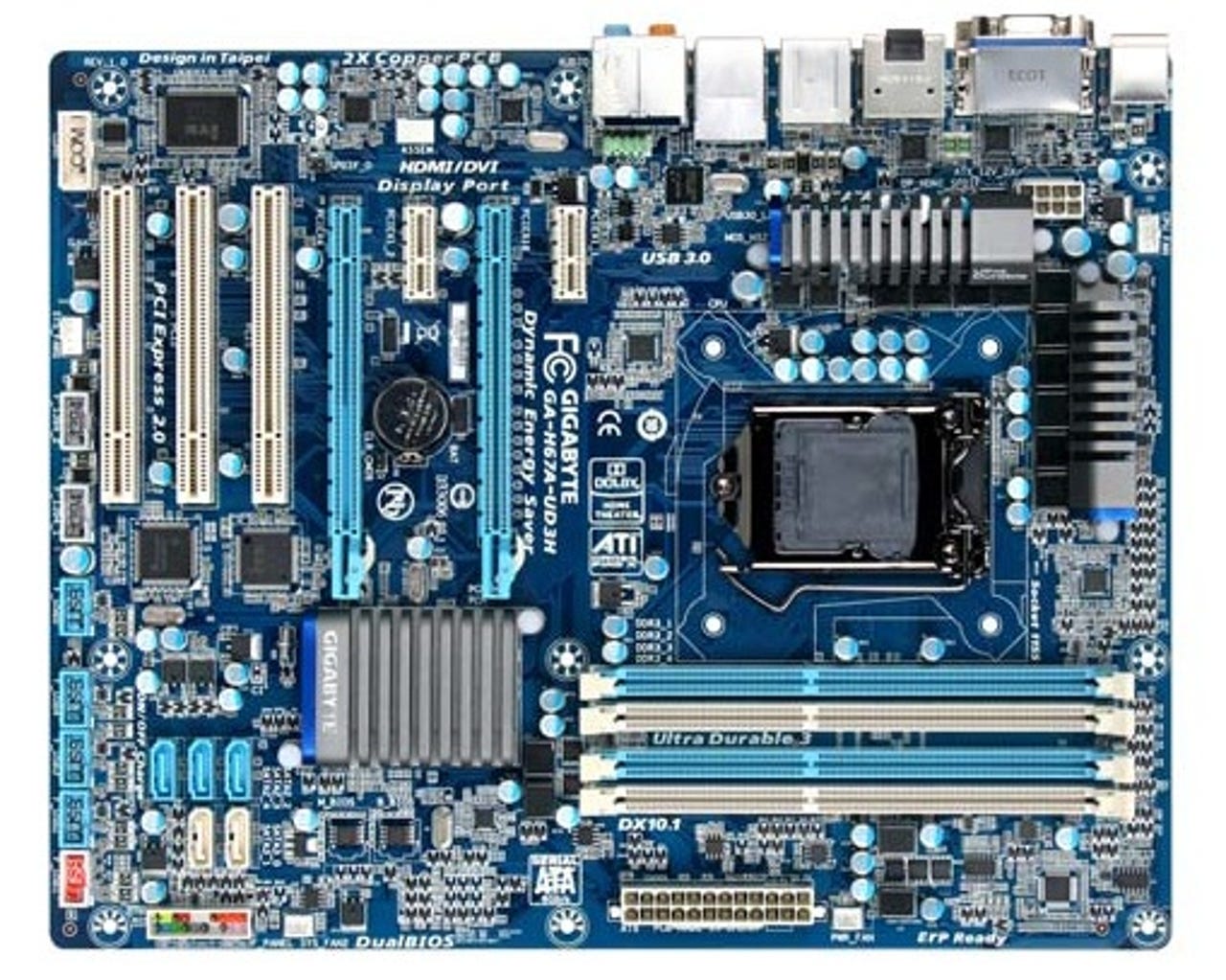Benchmarks: Intel's Sandy Bridge

The second generation of Intel's 32nm Core Processor Family, codenamed Sandy Bridge, introduces a new microarchitecture that delivers significant improvements in energy efficiency.
New Advanced Vector eXtensions (AVX) make for faster floating-point performance, while AES New Instructions help to deliver a significant increase in encryption performance. The latter are not included in all Sandy Bridge processors: only Core i5 and i7 models offer AES-NI (which is supported, for example, by TrueCrypt 7.0a), with Core i3 and Pentium models missing out.
All Sandy Bridge processors include integrated on-die graphics with, depending on the processor model, 12 or 6 GPU execution units. However, the new graphics solution still doesn't offer enough performance for demanding games. Overclocking is possible on 'K' variants thanks to the unlocked multiplier, although the integrated Turbo Boost function is likely to prove sufficient for most users. S and T variants, with 35W and 65W power envelopes respectively (compared to 95W for standard models) are particularly energy efficient.
Core-i7, i5 and i3 processors based on Sandy Bridge are available now, and cost between $127 and $317. Pentium variants will appear during the first quarter of 2011.

Sandy Bridge CPUs require a Socket LGA-1155 motherboard such as the Gigabyte GA-H67A-UD3H
Sandy Bridge processors require a Socket LGA-1155 motherboard with the new H67 or P67 chipset. The H67 chipset provides connections to the CPU's integrated graphics unit, while the P67 is designed for systems with a discrete graphics card. The number and type of motherboard connections depends on the particular product: the Gigabyte GA-H67A-UD3H, for example, offers HDMI, DVI, DisplayPort and a D-Sub connector. The GA-H67A-UD3H's four DIMM slots can hold a maximum of 16GB of DDR3/1333 memory. There is no USB 3.0 support on the H67 and P67, so motherboard manufacturers must deliver this functionality via a separate controller chip (Gigabyte provides two USB 3.0 ports on the GA-H67A-UD3H).
Performance
The PCMark Vantage test suite determines the performance of a system running applications under Windows Vista or Windows 7. The benchmark comprises a number of 'consumer scenarios' (Digital Memories, TV and Movies, Gaming, Music, Communications, Productivity and HDD), with the PCMark score denoting the average performance. The top score (17,028) was achieved by the system with the Core i7-2600K and discrete ATI Radeon HD 5870 GPU; the same system with Intel's integrated HD Graphics in place of the Radeon HD 5870 came third with a considerably lower score (14,884). The reason for this is a very weak performance in the individual 'GPU image manipulation' test (see below).
Windows 7 SP1 RC1 64-bit, ATI Radeon HD 5870 (1,024x768, 4xAA, 16xAF), 8GB DDR/1333; longer bars are better
Some programs, including Truecrypt 7.0a, now support AES New Instructions (AES-NI), which Intel introduced a year ago with its Clarkdale processors. There are 12 new AES encryption commands in total.
In the Truecrypt 7.0a test, the quad-core Sandy Bridge processors (Core i7-2600K and Core i5-2500K) come out clearly on top. The benefit provided by AES-NI support is clear when you compare the dual-core Core i5-661 (1,500MB/s) with AMD's six-core Phenom II X6 1100 (795MB/s). Intel's quad-core Core i7-870 — which, like AMD's chip, has no AES-NI support — delivers the worst result of all (504MB/s) in this test.
Windows 7 SP1 RC1 64-bit, ATI Radeon HD 5870, 8GB DDR/1333; longer bars are better
Under a different encryption method, AES-NI brings no advantage. Here, the Phenom II X6 competes very well with the Intel competition.
Windows 7 SP1 RC1 64-bit, ATI Radeon HD 5870, 8GB DDR/1333; longer bars are better
Thanks to Microsoft's DirectCompute API, certain computationally intensive tasks can make use of the GPU to boost performance under Windows Vista and Windows 7. Cyberlink's MediaShow Espresso 6 supports Sandy Bridge's integrated graphics: in tandem, the Core i7-2600K and HD Graphics converted a test video in 10 seconds, compared to 14 seconds using the CPU alone. Although ATI's HD Radeon 5870 is significantly more powerful than Intel's integrated GPU, there's no advantage evident in this test.
Windows 7 SP1 RC1 64-bit, ATI Radeon HD 5870, 8GB DDR/1333; shorter bars are better
The test with World in Conflict shows that Intel's new GPU is not suitable for demanding 3D games. The test systems fitted with ATI's HD Radeon 5870 achieved 45-56 frames per second, compared to Intel HD Graphics' paltry 3fps.
Windows 7 SP1 RC1 64-bit, ATI Radeon HD 5870 (2,048x1,152), 8GB DDR/1333; longer bars are better
Intel's new Sandy Bridge architecture represents a big step in energy efficiency, as is evident in the system power consumption results. In sleep mode, the Core i7-2600K/HD Graphics system draws only 33 watts. With ATI's Radeon HD 5870 the figure rises to 53W — almost 20W less than the Core i7-870 system with the same GPU. The new Intel H67 chipset probably also makes a contribution to the more frugal energy budget.
Windows 7 SP1 RC1 64-bit, ATI Radeon HD 5870, 8GB DDR/1333; shorter bars are better
A similar pattern emerges under full load. The Core i7-2600K/HD Graphics system draws 135W, rising to 151W with the ATI Radeon HD 5870, while the Core i7-870/ATI system draws 206W. The most power-hungry system under full load is the one powered by AMD's Phenom II X6 (244W).
Windows 7 SP1 RC1 64-bit, ATI Radeon HD 5870, 8GB DDR/1333; shorter bars are better
In addition to the overall PCMark score, Futuremark's PCMark Vantage suite provides various test scenarios. The Memories scenario measures the system's performance when handling digital photos and video. This test is remarkable for the relatively weak performance of the Core i7-2600K with the integrated HD Graphics rather than the discrete ATI Radeon HD 5870.
Windows 7 SP1 RC1 64-bit, ATI Radeon HD 5870, 8GB DDR/1333; longer bars are better
Within the Memories scenario, the 'GPU image manipulation' test uses the GPU's shader units for colour correction and other image processing tasks. The discrete ATI Radeon 5870 achieved 932fps in this test, while Intel's integrated HD Graphics managed only 83fps (see below) — hence the latter's poor overall result.
To use the AVX unit, which offers enhanced floating-point performance under Windows 7, you need Service Pack 1. Unfortunately, this update is currently only available as a Release Candidate, although Microsoft plans to ship the final version soon. AES-NI is supported by Windows by default, but application support for the instruction set is also required. As the TrueCrypt 7.0a reaults show, the new Sandy Bridge processors can deliver impressive results with everything in place.
Sandy Bridge's integrated HD Graphics processor cannot match high-end solutions from AMD and Nvidia when running demanding 3D games. When it comes to video playback and video encoding, however Sandy Bridge is competitive. In December, Apple announced its intention to use Sandy Bridge graphics in its upcoming MacBooks.
Intel's new Sandy Bridge processors represent a successful development of the Core microarchitecture. In addition to much-improved memory performance and significant instruction set extensions, the new chips are particularly impressive in terms of energy efficiency. It's a shame that the existing Intel LGA-1156 platform does not allow a CPU upgrade. To use the new Sandy Bridge processors, you must have a new motherboard with Socket